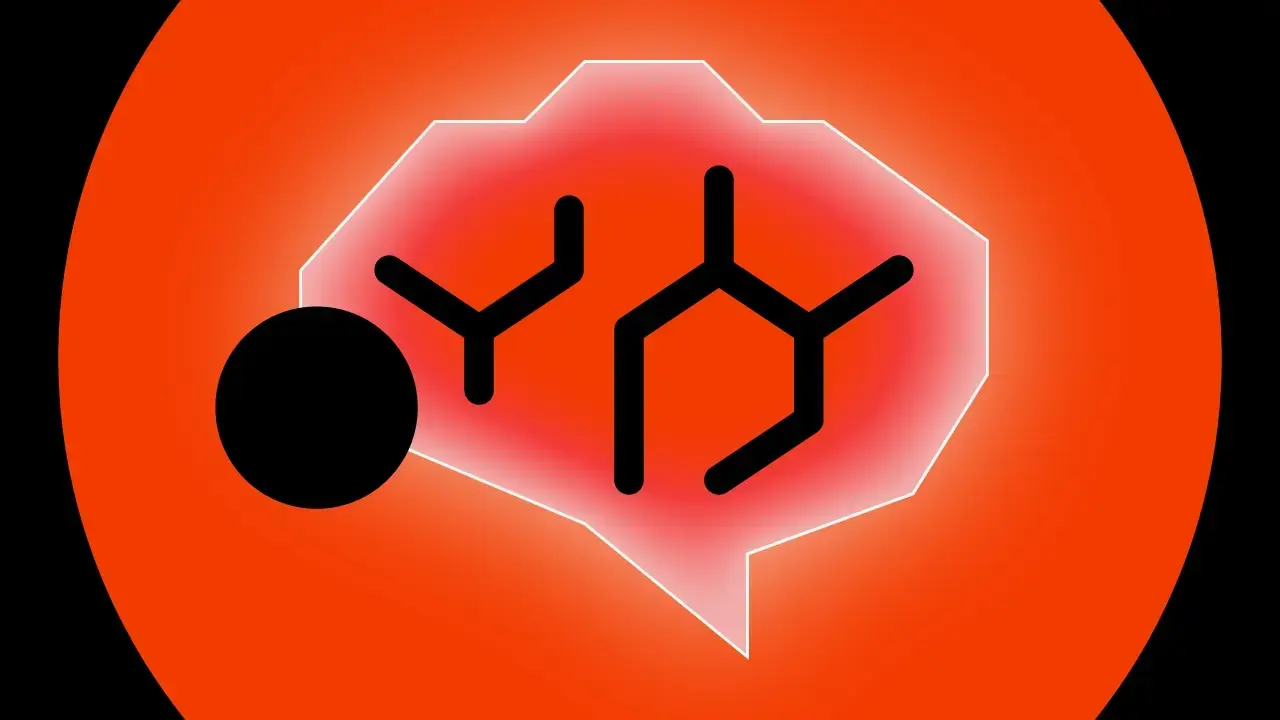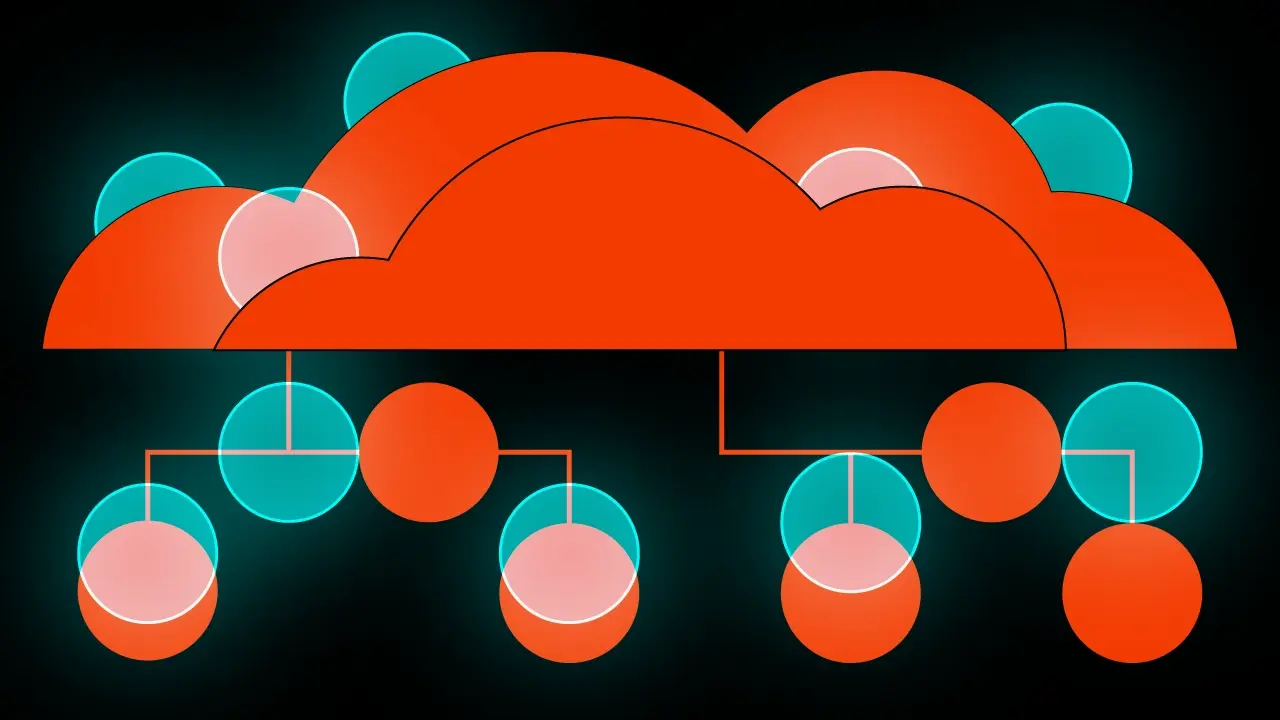The hidden costs of IT: how to find and control them


Developers spend up to 42% of their time dealing with technical debt, a problem that costs the global economy nearly $85 billion a year, according to an analysis by Stripe. This hidden but measurable expense is just one of many reasons why effective budget control remains a central challenge for businesses running IT projects. This article will examine the causes, compare different supplier collaboration models, and outline strategic and tactical ways to manage costs throughout a product’s lifecycle.
Key information
- The scale of the challenge: According to the CHAOS report, only 31% of IT projects are fully successful. Half of all projects go over budget or fall behind schedule, while another 19% are cancelled before completion.
- The cost of mistakes: A requirements error is 15 to 20 times more expensive to fix during testing or after launch than it is during the initial analysis phase.
- Cloud efficiency: Inefficient cloud resource management is a major drain, with global waste expected to reach $225.9 billion in 2024, representing about 32% of total spending on such infrastructure.
- The impact of technical debt: Research from Forrester shows that technical debt can consume between 10% and 20% of the budget for new product development.
- Scope creep: Uncontrolled expansion of a project’s scope is the main reason for budget overruns in 62% of cases.
- The client’s role: Analyses by the Project Management Institute show that organisations investing in proven management practices waste 28 times less money.
Why IT budgets still spiral out of control
Decades of technological progress have done little to solve a persistent business question: why do so many IT projects still run over budget and behind schedule? As far back as 1994, the groundbreaking Standish Group report, known as the CHAOS Report, revealed that only 16.2% of IT projects succeeded by delivering on time, on budget, and with all features intact. A majority, 52.7%, were described as “challenged”—exceeding their budget, falling behind schedule, or providing limited functionality—while the remaining 31.1% failed completely.
One might assume that project management has improved over the years. Yet more recent data from 2020, while showing a slight improvement with the success rate rising to 31%, indicates that 69% of projects still either fail or face serious trouble. These figures prove that the difficulty in controlling costs is a persistent, systemic issue.
The financial consequences are enormous. A 2024 study by Accenture Capital Projects showed that 66% of organisations miss their project goals, with an average cost overrun of 29%. This points to a fundamental need to rethink optimisation—not as a reactive spending cut, but as a strategic approach to managing value throughout a project’s lifecycle. To do that, we must first understand where the costs truly come from.
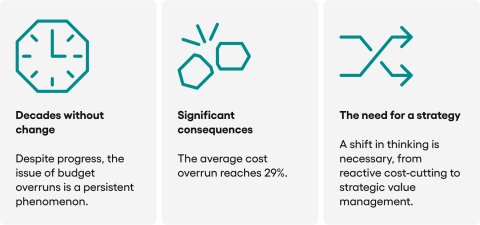
The anatomy of a modern IT project’s costs
The costs of an IT project extend far beyond programmer salaries. They form a complex structure with many hidden, long-term components.
The cost of the team
This includes not only salaries based on experience but also the hidden costs of staff turnover, which causes delays and adds expense. The loss of project knowledge and the time needed to bring new team members up to speed represent real financial losses.
As Frederick Brooks demonstrated in his foundational work, The Mythical Man-Month, adding more people to a late project often makes it even later. This principle, first articulated in the age of mainframe computers, is more relevant than ever in an era of remote and distributed teams.
Infrastructure and tools: a dynamic and unpredictable expense
As cloud computing became the standard, managing its costs has emerged as a new and important area for optimisation. The McKinsey Technology Trends Outlook 2025 highlights that the surge in demand for computing power, driven by generative AI, is placing additional strain on data centres and energy grids.
This directly translates into higher operational costs. Managing AI and machine learning expenses is now a top priority for finance teams in IT. On top of this are the costs of software licences, DevOps tools, and CI/CD platforms. According to Capaciteam, these expenses can account for 10–15% of the budget for a simple project, rising to as much as 25–30% when advanced, specialised technologies are used.
Regulations and integrations: costs that cannot be ignored
From the very beginning, a project must account for the costs of security, compliance with data protection regulations like GDPR, and industry audits. Neglecting these areas can lead to financial penalties and reputational damage that far exceed any initial savings. A similar pattern was seen with the implementation of the PSD2 directive. Although it brought market benefits, for most banks the implementation costs significantly outweighed the revenues gained.
The quality of requirements: the biggest hidden cost lever
Research popularised by Steve McConnell shows that a requirements error that costs one unit to fix during the analysis phase becomes 15–20 times more expensive if discovered during testing.
This is confirmed by analysis from McKinsey, which indicates that the average budget overrun in IT projects is 66%, often as a direct result of poorly defined requirements. Empirical data modelling presented by Wobe Systems demonstrates that just a 10% improvement in the quality of requirements for a half-million-euro project can lead to savings of €72,000.
Technical debt and TCO: the invisible budget burden
Choosing a cheap but inflexible technology can lead to vendor lock-in and growing technical debt. This concept, further developed by Martin Fowler, compares compromises in code quality to financial debt.
Over time, this debt accumulates and generates “interest” in the form of slower development, quietly consuming the budget intended for innovation. The initial project cost is often just the tip of the iceberg; the true financial picture only emerges from an analysis of the Total Cost of Ownership (TCO).
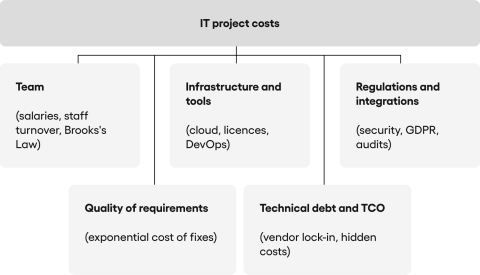
Critical areas: what drives up the project price?
A project’s final cost is a result of several key factors whose impact can be estimated based on market realities.
The most fundamental factor is scope and complexity. According to data from Cleveroad, highly complex projects that require an advanced architecture, such as microservices, can cost an additional $50,000 to $150,000 in the design phase alone.
System integrations also play a large part. The cost of integrating with existing systems like CRM or ERP can range from $15,000 to over $75,000, depending on their number and complexity. The global market for application integration, valued by Market Research Future at $23.25 billion in 2024, is projected to grow to $45.25 billion by 2034.
Testing and quality assurance (QA) activities consume a significant portion of the budget. Research by Lotus QA indicates this can be from 15% to 25%, with an average of 23%. The costs of different types of testing can vary widely, from $3,000 for basic functional tests to over $50,000 for in-depth security audits, as estimated by Morsoftware.
Delays generate measurable losses every day. For a large $50 million project, an average delay of 30% can translate into a loss of nearly $15 million, as calculated by Ingeniva. On a macro scale, poor project performance leads to a waste of 9.9% of every dollar invested, according to data from TeamStage.
External factors like regulations have a direct impact on costs. The introduction of GDPR, for example, caused an average 8% drop in profits for affected companies, mainly due to compliance expenses, as reported by CEPR.
PwC data suggests these costs can exceed €10 million annually for some organisations. A similar mechanism was at play with the PSD2 directive, which, as an analysis by Payneteasy shows, resulted in implementation costs exceeding the profits gained for most banks.
How to match the collaboration model to the project strategy
Choosing a collaboration model is a fundamental decision that determines the fate of a project. It is not just a matter of a formal agreement but a conscious choice of a working philosophy that shapes the cost structure, risk allocation, and flexibility of the entire undertaking.
The fixed price model: is the apparent security of a fixed price worth it?
In a fixed price model, the scope, schedule, and total cost are precisely defined and agreed upon upfront. This approach offers a high degree of budget predictability, making it attractive to organisations with strict financial planning. It works best for small, well-defined projects, such as building a minimum viable product (MVP).
The seeming predictability of this model comes with significant drawbacks. Its primary limitation is a lack of flexibility, as every change requires time-consuming and costly renegotiations. According to a 2024 PMI Pulse report, 31% of fixed price contracts generate unexpected extra costs. In this model, the supplier bears all the risk of underestimation. This can lead to the supplier either inflating the initial quote to create a safety buffer or, when facing difficulties, cutting corners on quality to stay within budget.
The time & material model: a flexible response to uncertainty
When a project’s scope is difficult to define at the outset, the time & material (T&M) model is often the best fit. Here, the client pays for the actual time the team works and the resources used. This model shifts most of the financial risk to the client but offers maximum flexibility in return. It naturally aligns with agile methodologies, where the project scope evolves in response to market changes and user feedback.
The greatest advantage of T&M is the ability to start a project quickly without needing a months-long, exhaustive specification. The team can begin work on the most important features immediately, with details of subsequent stages clarified as work progresses.
This gives the client full control over priorities. The main disadvantage is the lower predictability of the final budget. To control costs effectively, this model requires active and informed participation from the client, including regular progress monitoring and ongoing decisions about scope.
The dedicated team model: a partnership for the long haul
The dedicated team model is a form of collaboration where a client engages a full team of specialists who function as an extension of their own organisation. This approach is most often chosen for long-term product development, where operational continuity and the retention of project knowledge are important.
The advantage of this solution is the ability to build a strategic partnership. Over time, the team gains a deep understanding of the product, the client’s business, and its organisational culture, which translates into higher-quality solutions and faster time-to-market. This model provides stability and predictable monthly costs. It is worth remembering, however, that the barrier to entry is higher, making it a solution primarily for larger entities and strategic initiatives.
Hybrid models: searching for a middle ground
In response to the complexity of modern projects, hybrid models that combine features of different approaches are growing in popularity. According to PMI data, their use has increased by 57% in recent years.
One such model is Capped T&M, which is a time & material model with a set budget ceiling, combining the flexibility of T&M with enhanced cost control. Another is Milestone-based Pricing, where payments are tied to the achievement of specific, clearly defined project goals.
The most advanced form is Outcome-based Pricing, where the supplier’s payment is partly or wholly dependent on the client achieving specific business results.
The planning phase: where key cost decisions are made
The greatest opportunities for cost optimisation appear long before the first line of code is written. The planning phase, though often undervalued, is where decisions with a fundamental impact on the budget are made.
An investment in analysis that pays for itself many times over
Activities such as product discovery workshops and in-depth business analysis are not “pre-project costs” but investments with an extremely high rate of return. It is at this stage that the main causes of project failure identified in th CHAOS report can be addressed. Every hour spent precisely defining the business problem saves dozens of hours of development work.
The MVP as a tool for budget discipline
One of the most effective strategies is to consciously limit the initial scope of the project to an absolute minimum (the Minimum Viable Product, or MVP). This approach not only lowers the entry cost but also speeds up the product’s market launch, allowing for the collection of key data from real users before significant funds are invested in less important features.
The role of the product owner and a clear decision-making process
A lack of clarity and delays in decision-making generate measurable costs. Every day a development team waits for a decision or receives conflicting messages is lost time and money. It is essential to designate one person to act as the Product Owner, who has the final say on matters of scope and priorities.
Technology with the future in mind: a TCO perspective
Technology decisions made in the planning phase must consider the total cost of ownership (TCO), not just the implementation cost. A technology that is cheap to start with may prove extremely expensive to maintain and scale. Factors such as the availability of specialists, the maturity of the ecosystem, licensing costs, and the risk of vendor lock-in must be carefully analysed.
What is success? A definition based on metrics
A project without clearly defined key performance indicators (KPIs) is exposed to uncontrolled cost growth. Instead of defining success as “delivering a CRM system,” a measurable business goal should be set, such as “shortening the average sales cycle by 10%.” This definition prevents scope creep and protects against building features that do not translate into real financial results.
The implementation phase: how to manage costs during the project
Even the best plan requires iron discipline during implementation, where engineering and financial discipline must go hand in hand. The biggest enemy is scope creep; according to a PMI report, 50% of projects experience this phenomenon, which is the main cause of budget overruns in 62% of cases.
Metrics, automation, and a culture of quality
The fundamental rule is simple: the sooner a mistake is detected, the cheaper it is to fix. Continuous progress monitoring and feedback collection are essential tasks.
Equally important is the implementation of CI/CD (Continuous Integration/Continuous Deployment) processes, which automate testing and deployment, allowing for the early detection of defects. Market data confirms the benefits: Airbus reduced its testing time by over 70%, and AT&T saw a 90% drop in defects after adopting quality-oriented practices.
DORA metrics as a project health indicator
Research conducted by DevOps Research and Assessment (DORA) identified four key metrics that act as an early warning system. These are deployment frequency, lead time for changes, change failure rate, and mean time to restore service. They have a direct impact on costs.
Low-performing teams have a change failure rate of 46-60% and need between a week and a month to restore service after a failure. In comparison, the best teams keep this rate below 15% and restore services in less than an hour.
FinOps, or managing costs in the cloud
According to the State of FinOps 2025 report, inefficient management of cloud resources generated costs of $225.9 billion in 2024. Key FinOps practices include right-sizing (matching computing power to real load) and rate optimisation. Using discounts for long-term commitments can lead to savings of up to 72%. It is worth highlighting that DevOps and FinOps practices are inextricably linked; maturity in DevOps is a prerequisite for the successful implementation of FinOps.
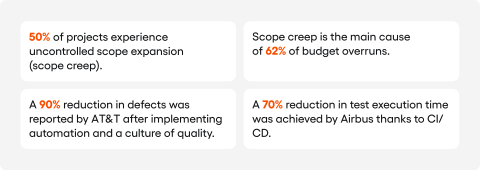
After launch: when the project ends but the real costs begin
It is during the maintenance phase that all the hidden costs and commitments from the earlier stages of a project materialise.
The hidden costs of maintenance
From a TCO perspective, maintenance costs often far exceed the initial implementation costs. Analysis by Capers Jones indicates that over the 25-year life of a large software system, nearly 50 cents of every dollar spent goes towards finding and fixing bugs. Maintaining legacy systems can consume as much as 55% of an entire IT budget, limiting funds available for innovation.
The real business impact of technical debt
Technical debt, the hidden cost of future rework caused by short-term compromises, is one of the biggest financial burdens in IT. A report by Stripe estimates that developers spend 42% of their time dealing with technical debt, which translates to a global loss of $85 billion a year in missed opportunities.
According to IT directors, 10% to 20% of the budget for new products is actually consumed by problems with existing debt. Ignoring this phenomenon leads to a situation where a system becomes so expensive to maintain that it effectively stifles all innovation.
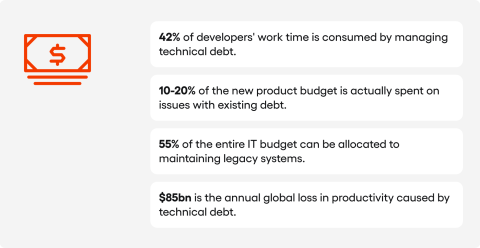
Conclusion: changing perspective from cost to investment
Effective cost optimisation in IT requires a fundamental shift in perspective: from a short-term focus on the project’s price to a long-term focus on its value and total cost of ownership (TCO). The real goal is not to minimise spending but to maximise the return on every pound invested.
The greatest threat to the profitability of technology projects is technical debt—the hidden cost of short-term compromises. The key to success is to manage it consciously and invest in quality at the earliest possible stages.
For management, the most important lesson is the need for active and informed involvement in the planning phase. It is the precise definition of business requirements that provides the most powerful lever for controlling costs, preventing expensive rework and ensuring the final product delivers real value to the organisation.
This blog post was created by our team of experts specialising in AI Governance, Web Development, Mobile Development, Technical Consultancy, and Digital Product Design. Our goal is to provide educational value and insights without marketing intent.



